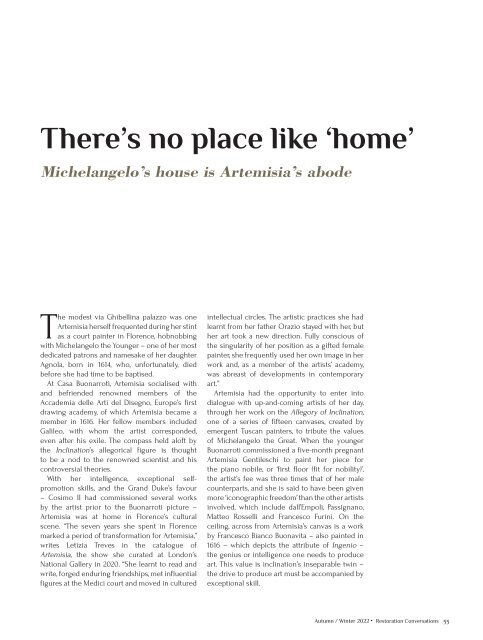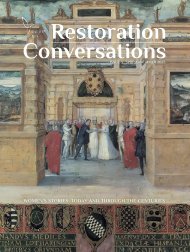Autumn/Winter 2022
Restoration Conversations is a digital magazine spotlighting the achievements of women in history and today. We produce two issues a year: Spring/Summer and Fall/Winter
Restoration Conversations is a digital magazine spotlighting the achievements of women in history and today. We produce two issues a year: Spring/Summer and Fall/Winter
You also want an ePaper? Increase the reach of your titles
YUMPU automatically turns print PDFs into web optimized ePapers that Google loves.
There’s no place like ‘home’<br />
Michelangelo’s house is Artemisia’s abode<br />
The modest via Ghibellina palazzo was one<br />
Artemisia herself frequented during her stint<br />
as a court painter in Florence, hobnobbing<br />
with Michelangelo the Younger – one of her most<br />
dedicated patrons and namesake of her daughter<br />
Agnola, born in 1614, who, unfortunately, died<br />
before she had time to be baptised.<br />
At Casa Buonarroti, Artemisia socialised with<br />
and befriended renowned members of the<br />
Accademia delle Arti del Disegno, Europe’s first<br />
drawing academy, of which Artemisia became a<br />
member in 1616. Her fellow members included<br />
Galileo, with whom the artist corresponded,<br />
even after his exile. The compass held aloft by<br />
the Inclination’s allegorical figure is thought<br />
to be a nod to the renowned scientist and his<br />
controversial theories.<br />
With her intelligence, exceptional selfpromotion<br />
skills, and the Grand Duke’s favour<br />
– Cosimo II had commissioned several works<br />
by the artist prior to the Buonarroti picture –<br />
Artemisia was at home in Florence’s cultural<br />
scene. “The seven years she spent in Florence<br />
marked a period of transformation for Artemisia,”<br />
writes Letizia Treves in the catalogue of<br />
Artemisia, the show she curated at London’s<br />
National Gallery in 2020. “She learnt to read and<br />
write, forged enduring friendships, met influential<br />
figures at the Medici court and moved in cultured<br />
intellectual circles. The artistic practices she had<br />
learnt from her father Orazio stayed with her, but<br />
her art took a new direction. Fully conscious of<br />
the singularity of her position as a gifted female<br />
painter, she frequently used her own image in her<br />
work and, as a member of the artists’ academy,<br />
was abreast of developments in contemporary<br />
art.”<br />
Artemisia had the opportunity to enter into<br />
dialogue with up-and-coming artists of her day,<br />
through her work on the Allegory of Inclination,<br />
one of a series of fifteen canvases, created by<br />
emergent Tuscan painters, to tribute the values<br />
of Michelangelo the Great. When the younger<br />
Buonarroti commissioned a five-month pregnant<br />
Artemisia Gentileschi to paint her piece for<br />
the piano nobile, or ‘first floor (fit for nobility)’,<br />
the artist’s fee was three times that of her male<br />
counterparts, and she is said to have been given<br />
more ‘iconographic freedom’ than the other artists<br />
involved, which include dall’Empoli, Passignano,<br />
Matteo Rosselli and Francesco Furini. On the<br />
ceiling, across from Artemisia’s canvas is a work<br />
by Francesco Bianco Buonavita – also painted in<br />
1616 – which depicts the attribute of Ingenio –<br />
the genius or intelligence one needs to produce<br />
art. This value is inclination’s inseparable twin –<br />
the drive to produce art must be accompanied by<br />
exceptional skill.<br />
<strong>Autumn</strong> / <strong>Winter</strong> <strong>2022</strong> • Restoration Conversations 55





